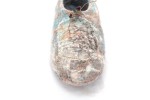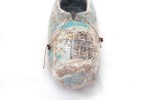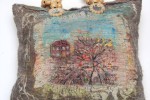Monotype on dense silk fabric
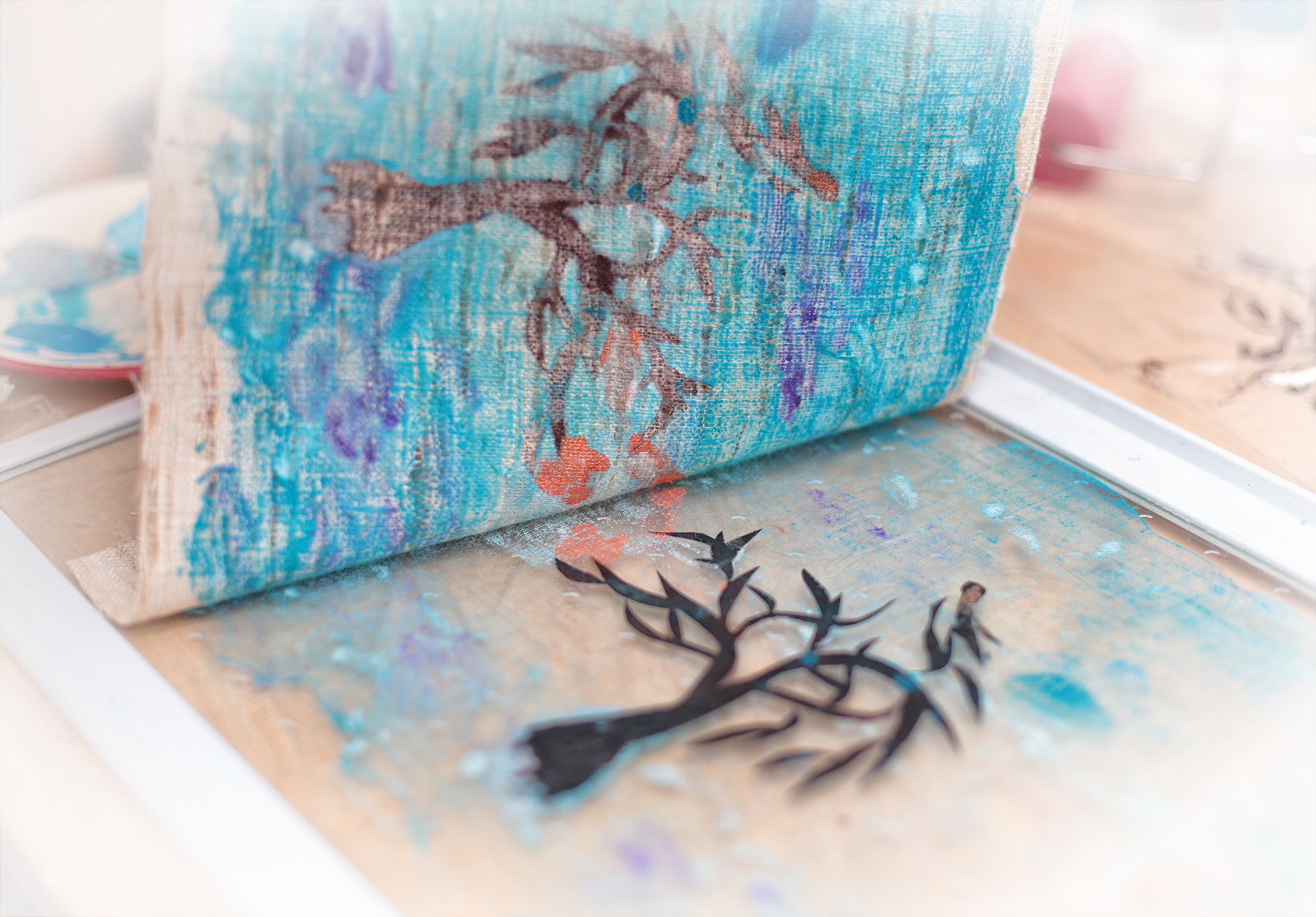
Very small theoretical part.
Monotype was born a long time ago (in 17th century). This print’s brother was born presumably by an Italian artist and graver Giovanni Castiglione. In theory, this technique is quite simple, like many other art ones as well. A person daring to try it should manually paint the image on any smooth surface (a glass, for example), and then, transfer the image on the paper using gravity, the force that very useful on Earth (I guess, Giovanni used a special machine with the heavy press for it). This technique refers to print ones. However, its feature that slightly depressing modern copiers is that the final image is unique in its kind. That means you cannot print a bunch of similar posters with this technique.
Nevertheless, you can do many other things. Like, for instance, develop your own or your children’s imagination. By the way, the imagination is very important thing in life. It can save you not only from boredom but also from different brain diseases in old age.
In fact, monotype is a very romantic technique similar to a summer day, soft and green forest outskirt and a picnic. This because in childhood (and some persons during the entire life), many people love to view the clouds guessing what it looks like. The monotype gives the opportunity to do this useful deed at home and in professional art studio as well (the second option is surely much more convenient and gives better results, but not so romantic when you sprinkling the paint around your cozy kitchen and driving away your ubiquitous and all involved cats and dogs at the same time).
Unexpectedly, the amazing creatures and worlds are very often born from mixing colorful spots. Downpours, snowfalls and landscapes get perfectly. Abstract works based on color harmony love this technique too.
Monotype helps a lot to psychologists who work in art therapy programs.
As for our master class (after such an introduction, you have to agree that its utility is indisputable), it will be focused on curious adaptation of this technique for printing unique images on fabric. What to do with these images is for our decision. You can, let us say, use it in other funny technique called felting. Actually, the idea of the master class originated from a question: “How did these slippers and such a handbag turn out?”
И вот как.
And that’s how.
Chapter 1 (the most extensive one). Preparing.
We are at home and we got the reactive monotype (you will understand why “reactive” below). Therefore, we need to prepare the work place: to cover the table by plastic film, to take everything you need, to stock up on rags and put an apron on.
What you need:
The smooth surface. It could be a glass or some other smooth thing like plastic, plexiglas or even printing film at the worst.
Paints and the surface where you can mix them (palette or porcelain saucer, for example). We will work with tissue, so we need acrylic paints on fabric. They can be liquid (about like water) and not so liquid (let us say, like 15% sour cream). We can use both. It depends on what exactly we want to portray. The liquid paints are suitable for abstract images and diffused landscapes. If we want some kind of shapes, we should take the second ones. Also, we can use inks for screen printing (they dry a bit longer). Because for slippers and handbag I needed the paint partly washed off in order to get shabby and coziness effect, I also used the ordinary acrylic art paints that, nevertheless, quite hardly washing off from the fabric.


The tissue. I chose the silk fabric because of the features of felting. Yet, you can use any other natural cloth like cotton or flax. The tissue can be quite thin or dense, but it is necessary to take into account that you will spend more paint for dense cloth to get bright enough print.
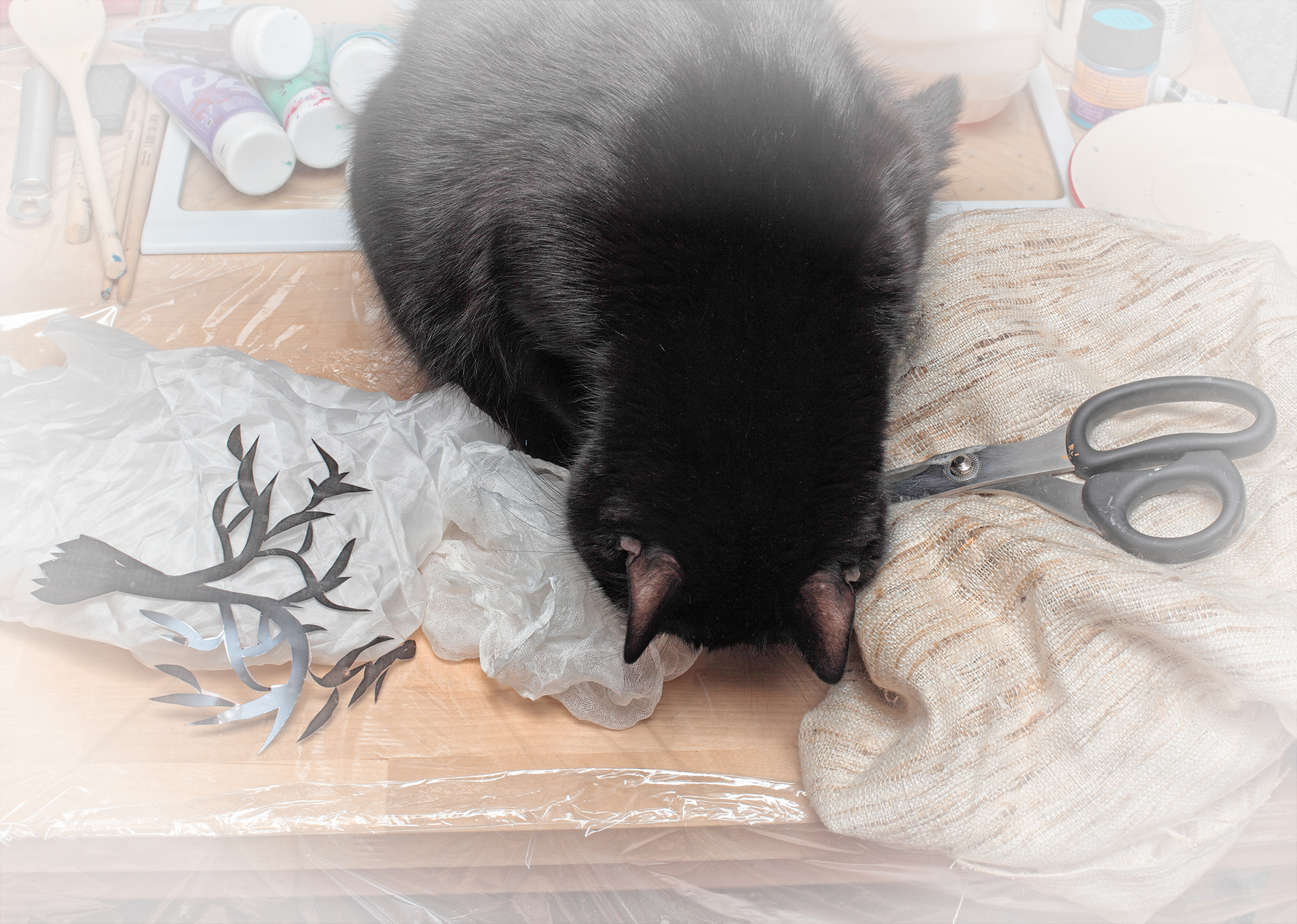

Gravity. In our case, I myself played the role of this force using rolling pin and wooden spoon. It was a bit hard, but by this way, we are adding in our cocktail a pinch of physical activity and fun.
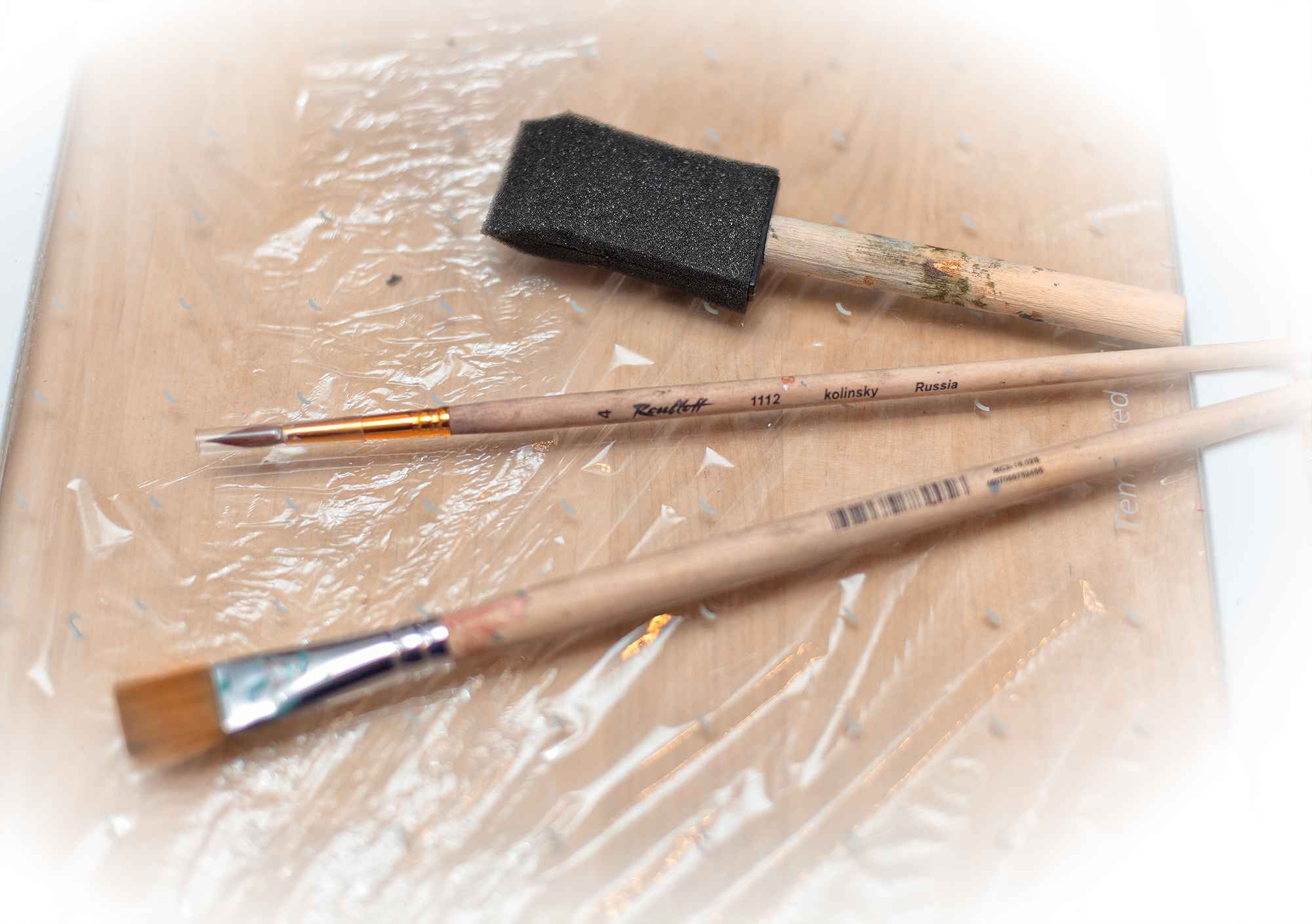
Brushes, sponges and putty knives. All these tools can be used for applying paint. After different experiments, you can learn to use the stiff bristles or the soft fibers of brushes for creating the certain texture and putty knives – for “blind spots”. True, for such experiments, nevertheless, it is better to use paper since the tissue eats most of this effort due to its softness. But the masters do not care at all. Thanks to curiosity, any obstacle can be wrapped up for the benefit of the future miracle of creativity.
Package, polyethylene, film, paper or an unnecessary rag that absorbs little moisture. Generally, the thing that you can use for covering the working surface with the tissue for pressing.
The surface where we will cut out the clear shape. In our case, that is the wooden board and the tool for cutting – the scissors or a special pen (I used the second).
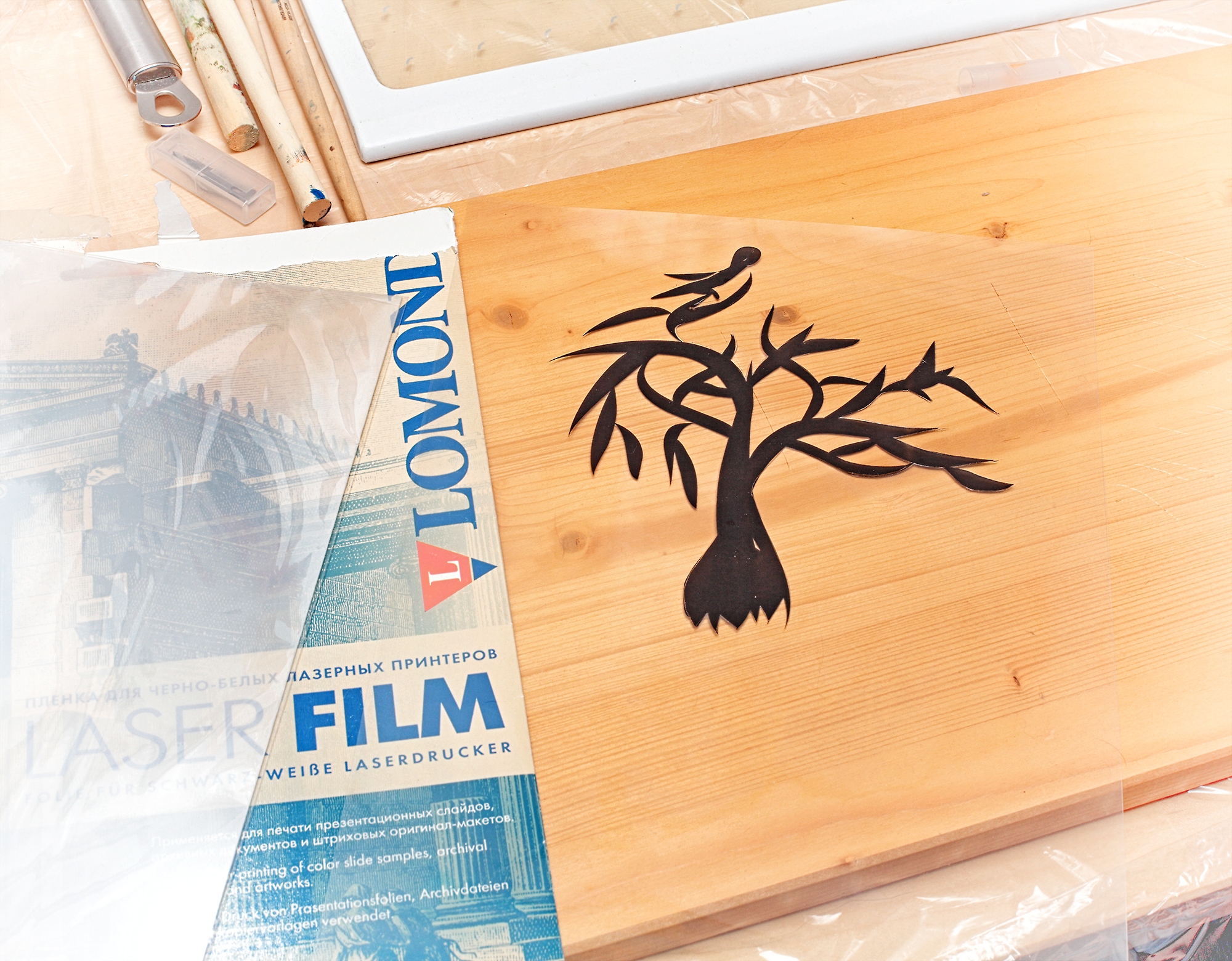

Chapter 2. Cutting out the clear shape.
So, we start from cutting out the clear shape. I drew it in graphic software and then printed on the special transparent film. That is a tree! We need a wooden board to avoid damage of our table while cutting by a special pen. They use such a clear shape to make a concrete symbol, which is very hard to get using fast drying paints, especially acrylic ones. The inks for screen-printing surely dry longer, but anyway monotype is a race. We got very little time for applying the image, so we previously have to imagine and plan what we want to get as a result. Only after obtaining the print, we can watch what appearing as a surprise and then left it as a mystery or try to turn into a recognizable shape. You can also cut out the shape by a sharp small scissors. Moreover, that is not necessary to print you can simply draw it. Pay your attention that the shape for printing on tissue should not have many tiny details (they could be smudged by careless gesture and blur on the cloth). Cutting out the small details is a quite labor-intensive and time-consuming task and you should be ready for hours of work.

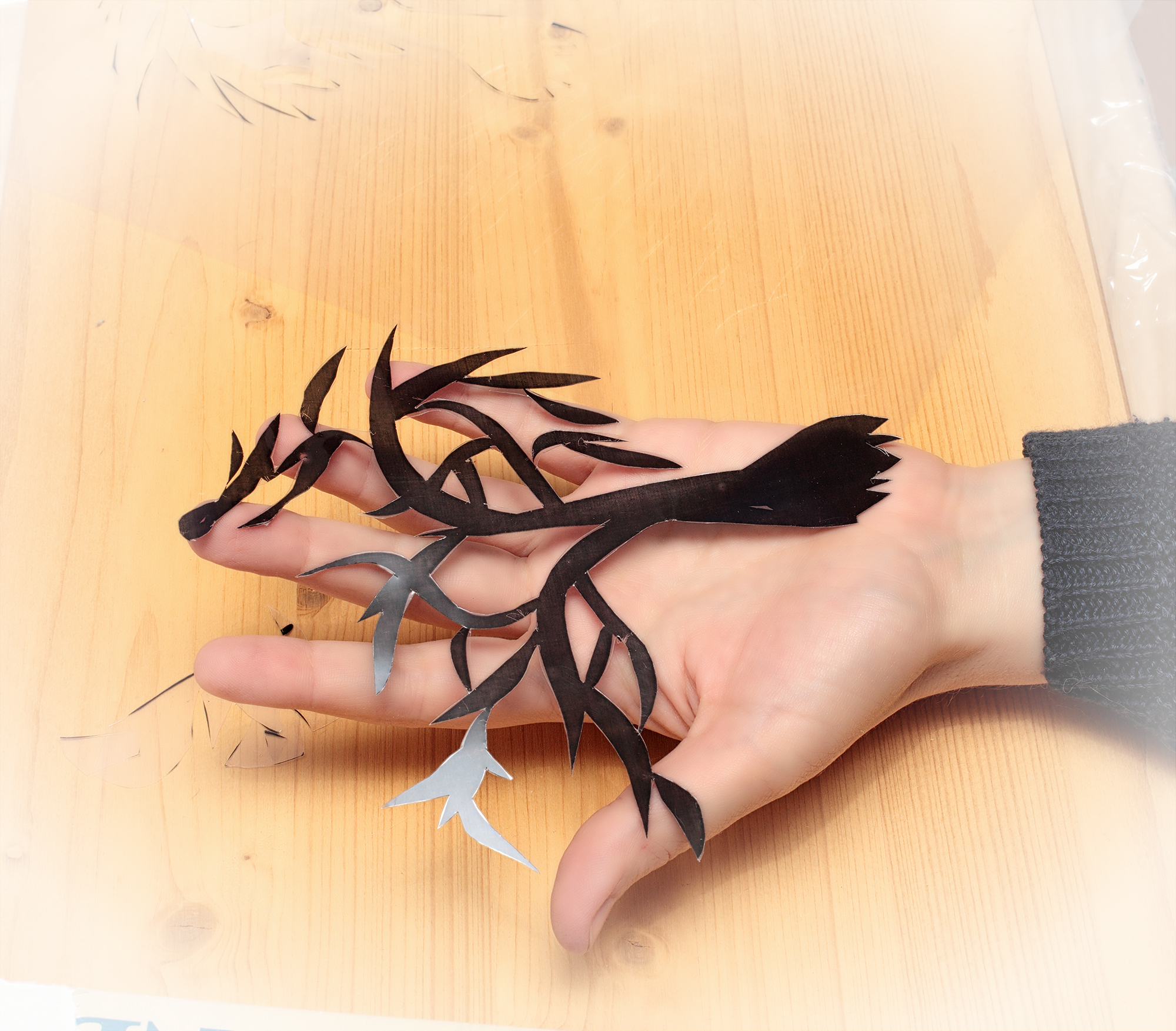
Chapter 3. Glass, tissue and a head.
Now, we remove the board, film and pen, and get the glass. By the way, in my case, the glass is a shelf from the fridge. Acryl is simple to wash from the glass, so we can use the acting shelf but only its smooth side. Sometimes, as a smooth surface I take glasses from frame including Plexiglas or different glassy plastic clerical sheets (they usually cover the table and people enclose schedules, calendars and other things under them).
Wet the cloth a bit by a sprayer. The more wet the tissue the more blurred image we will get after printing.

Before applying the paints, remember that you need to have an idea and a plan in your head, you should choose the paints and a color scheme. However, during the process set your fantasy free and if something gets into your head while colorful moment, do not be afraid to include it into your composition.

Chapter 4. The race (you can add “faster!” to every word and action).
So, we apply the paints trying to do everything quickly, remembering that paints are drying. We chose a dense raw silk, so we need many paints.

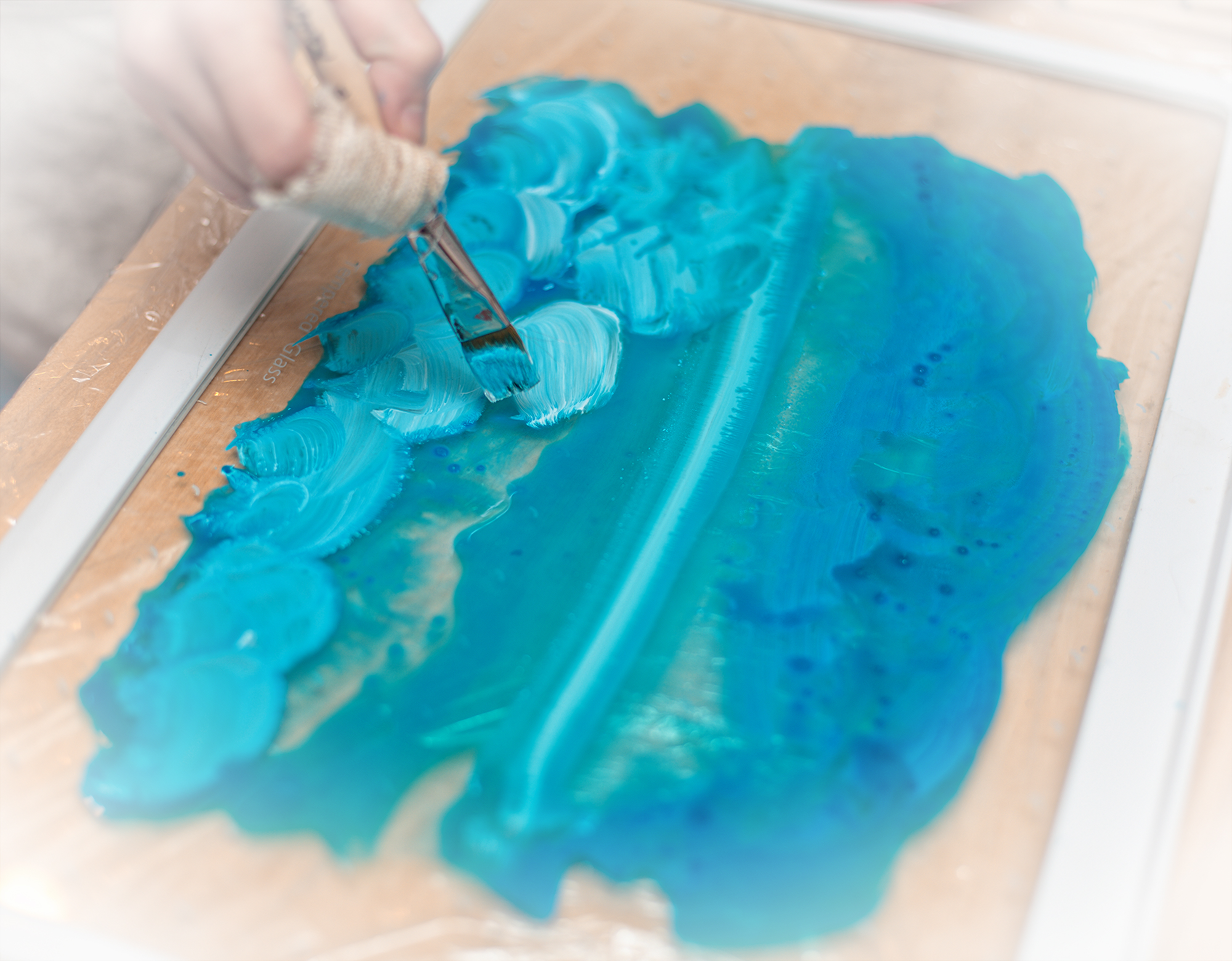
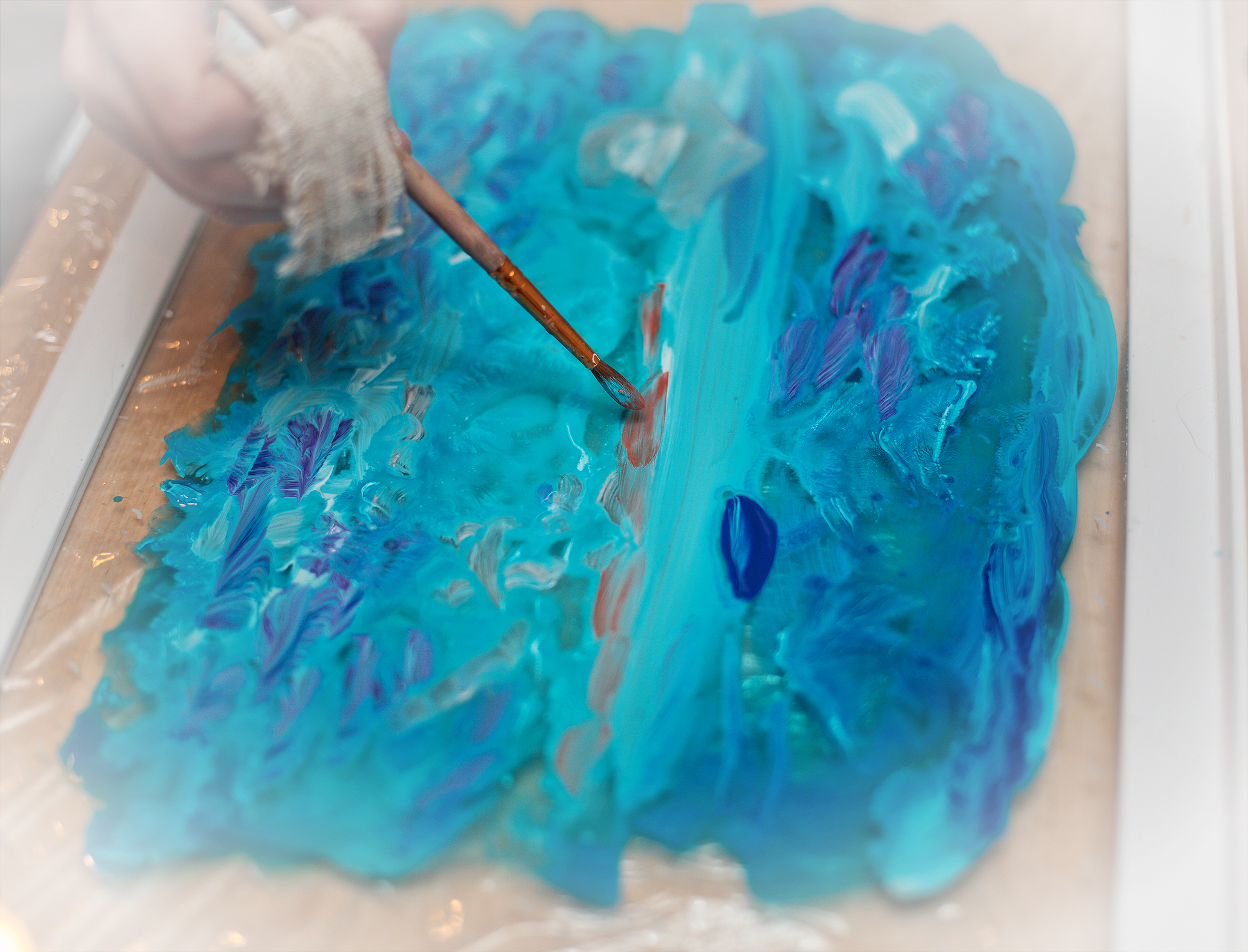
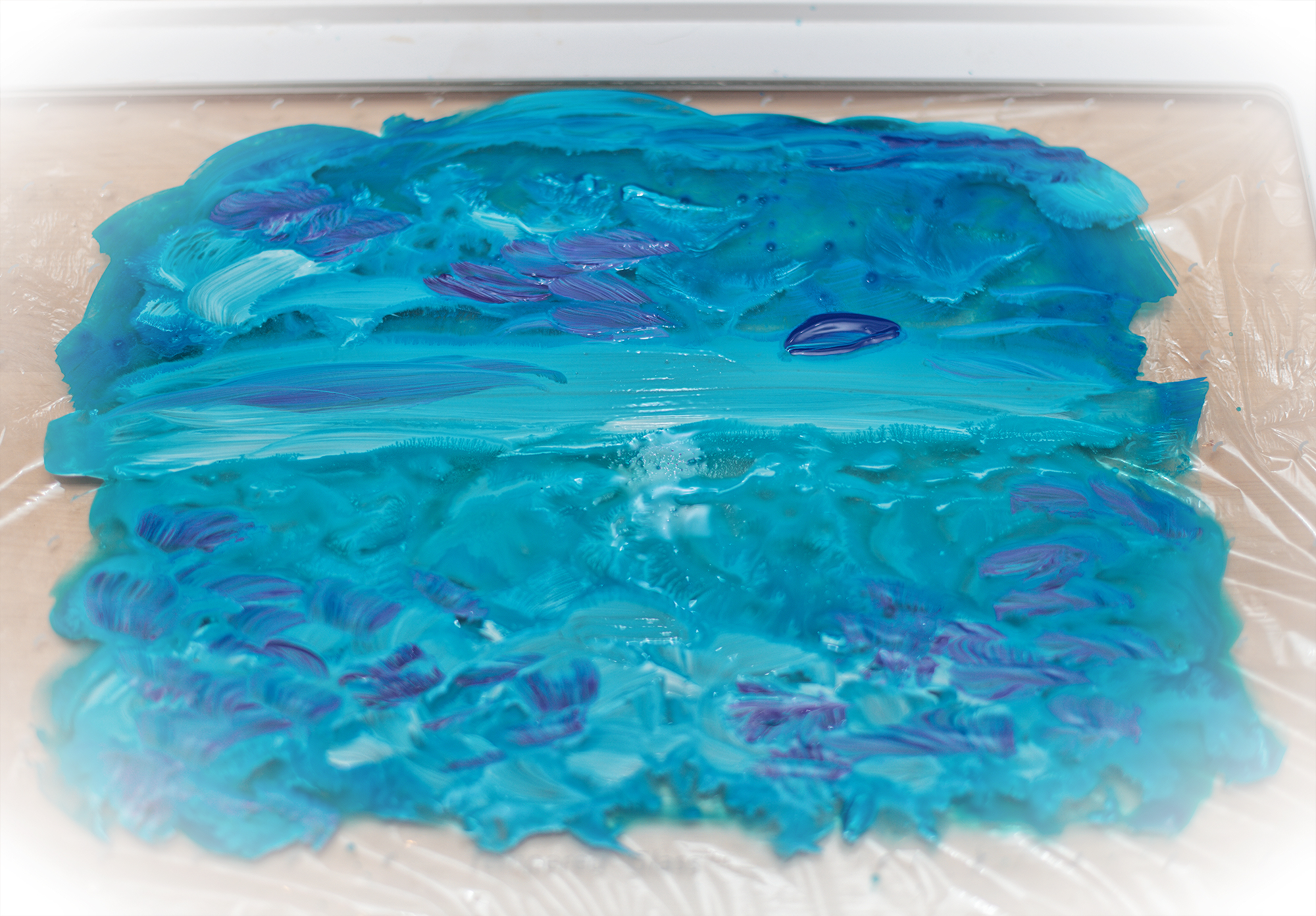
You can use the clear shape to make a blind spot i.e. unpainted surface or, as in our case, paint it in the certain color and put in the right place of working space. By the way, it is better to paint the smooth side; my film also has a rough one. We paint our tree just before applying on the tissue because we need simply to paint and put it in the chosen place. Its important do not let the paint to dry as its coat thinner than on the main surface.
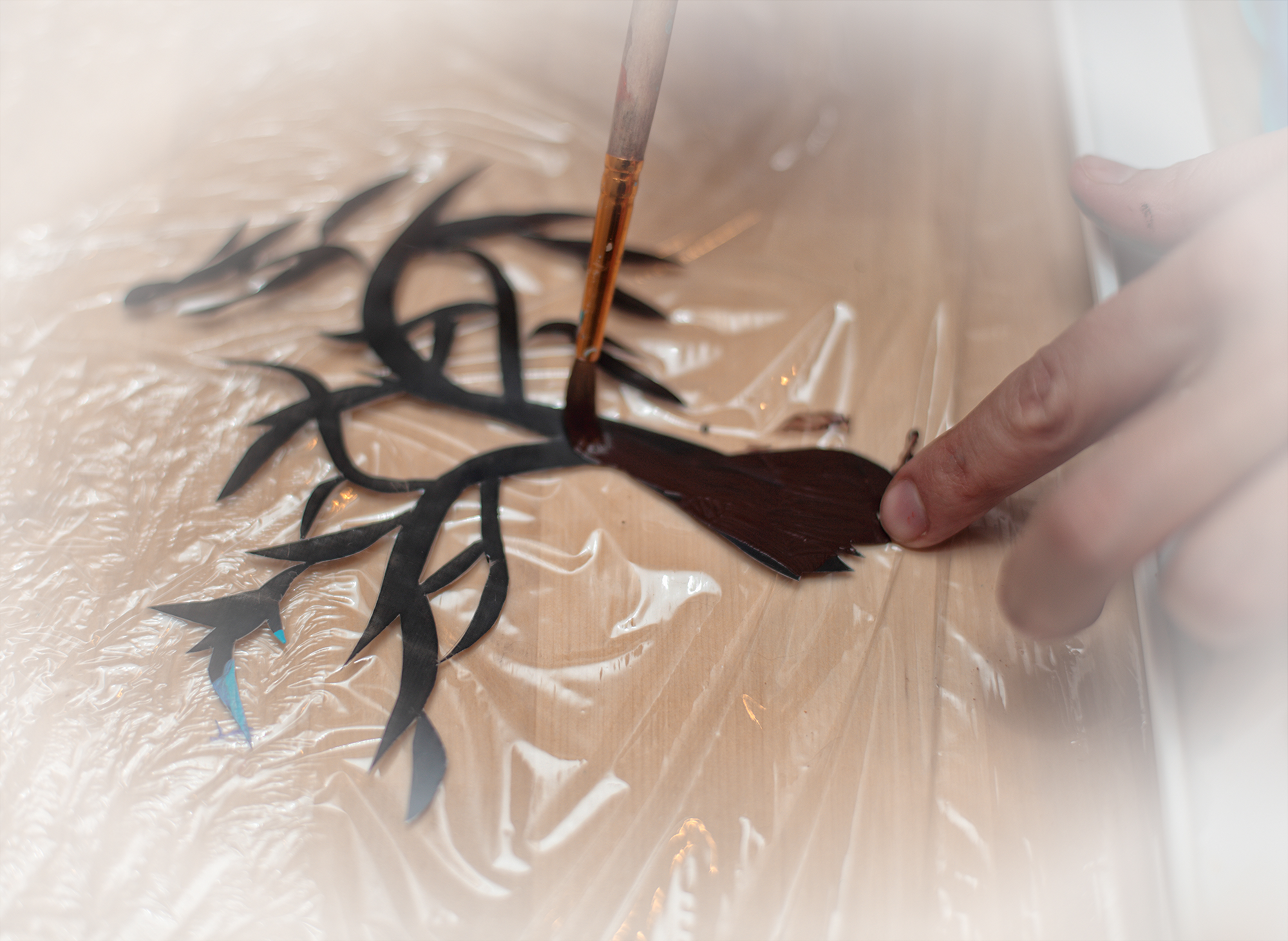
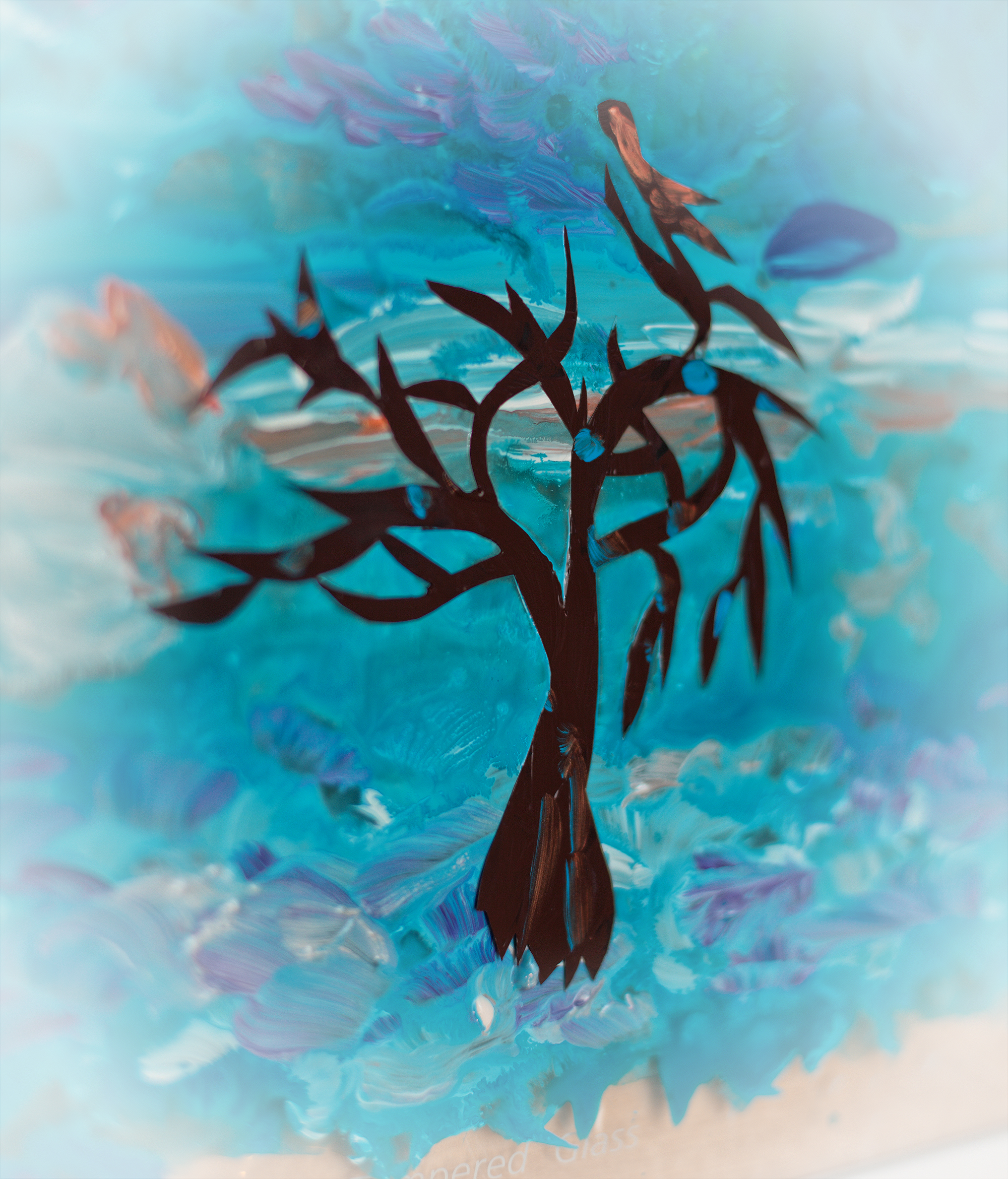
You can wet the working part by water before applying the fabric. It works only if paints dried out a tiny bit. However, if they “frozen”, you will have to start everything from the beginning.
We lay the tissue accurately and carefully press it down with hands in several places by point pressures (do not stroke it to avoid image displacement).
Chapter 5. Gravity.
Now, we need to put something on top, in my case it was a package. Accurately pressing, we start to work with a rolling pin or a hard roller. You can also use the sheets of paper and work with a wooden spoon, relying on working space and pressing down, do the circular motions by it. Our task is quite carefully (not moving the tissue and accordingly without smearing the picture), but strongly enough at the same time (we represent the press), to press the paint into the fabric in a sense. We can see how much the cloth was impregnated with the paint: our image shows through the other side. Moreover, we need to press until it keeps show up. If we see that our efforts stop bring the fruits, we can remove the tissue and watch the result.
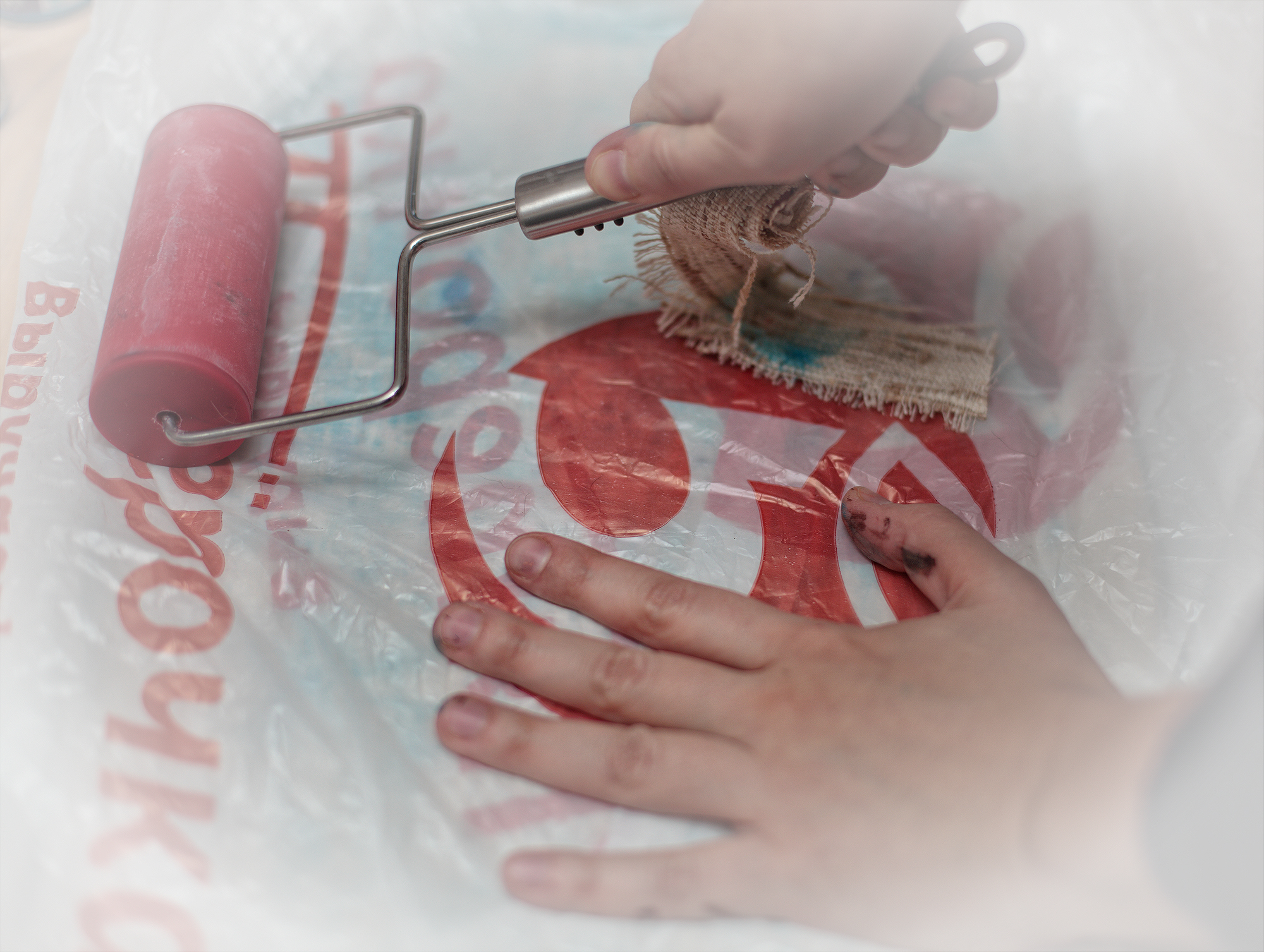
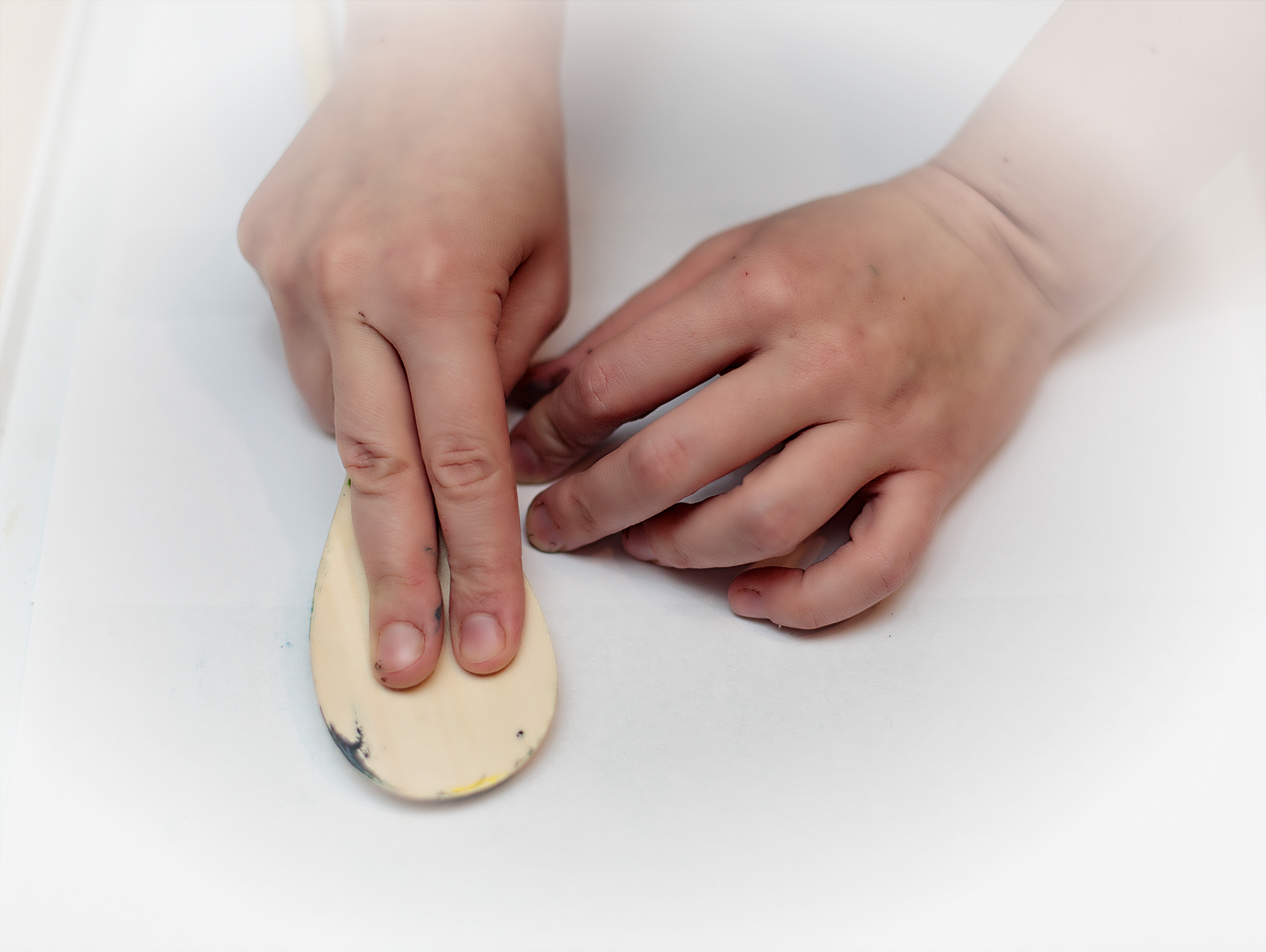
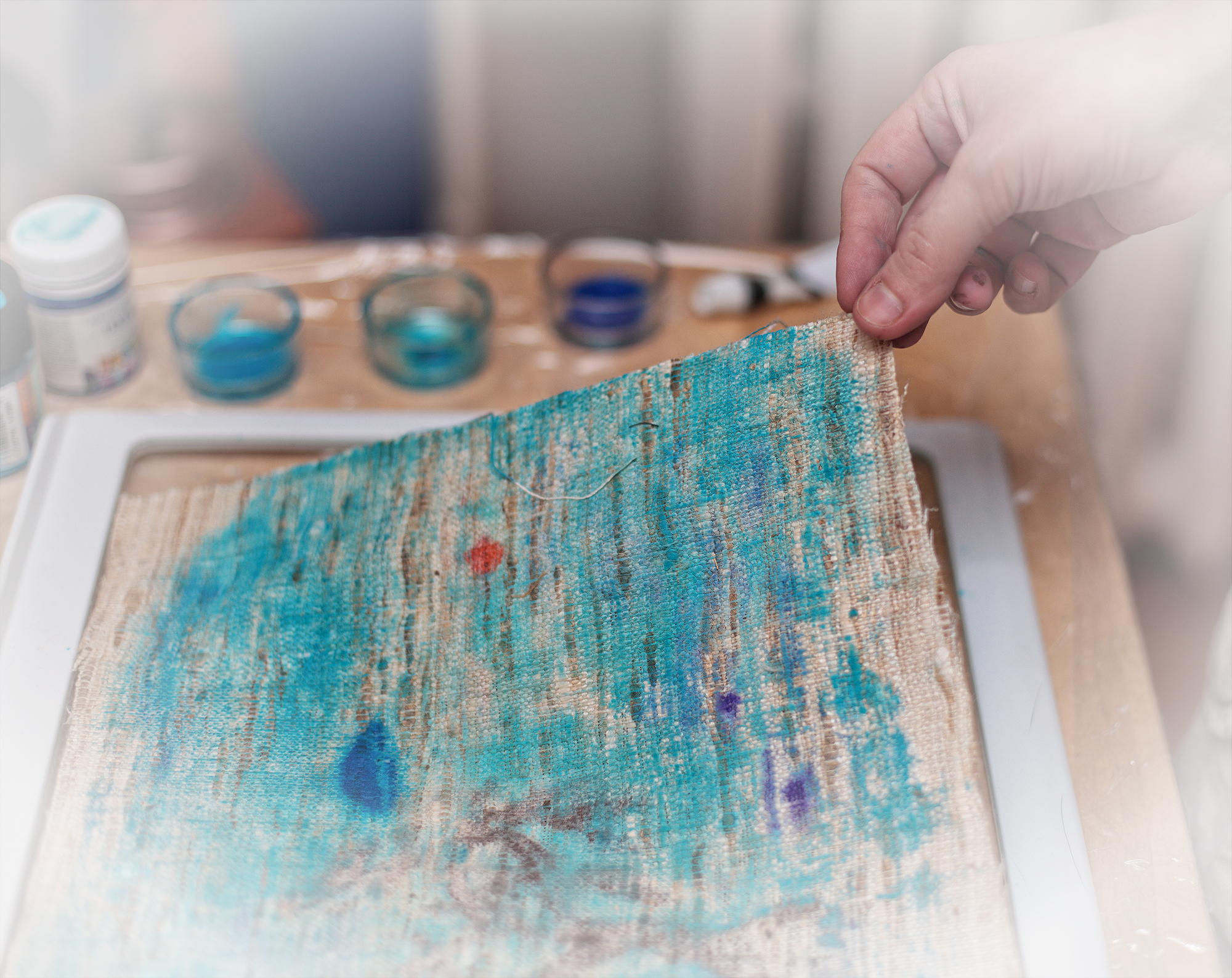
Chapter 6. Race again.
Our fabric is very dense, so we need to repeat the procedure. The difficulty is that quite hard to combine our clear shape with the print. It is difficult but possible. In order to get it, we quickly paint the shape and combine it with the silhouette just right on the tissue. Then, we apply the missing strokes on the glass even faster and lay it on the fabric again. Further, we repeat the game in the press.
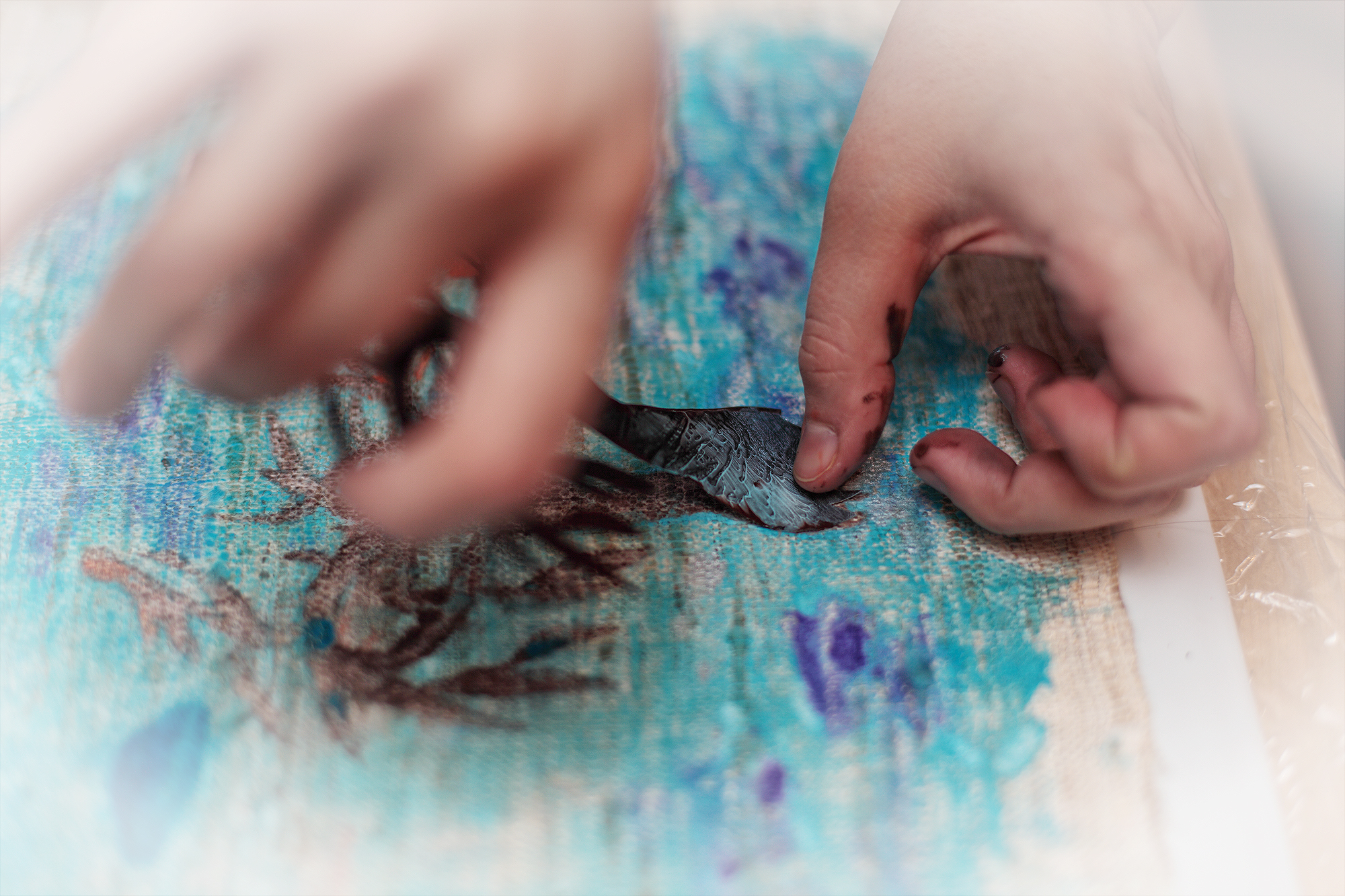
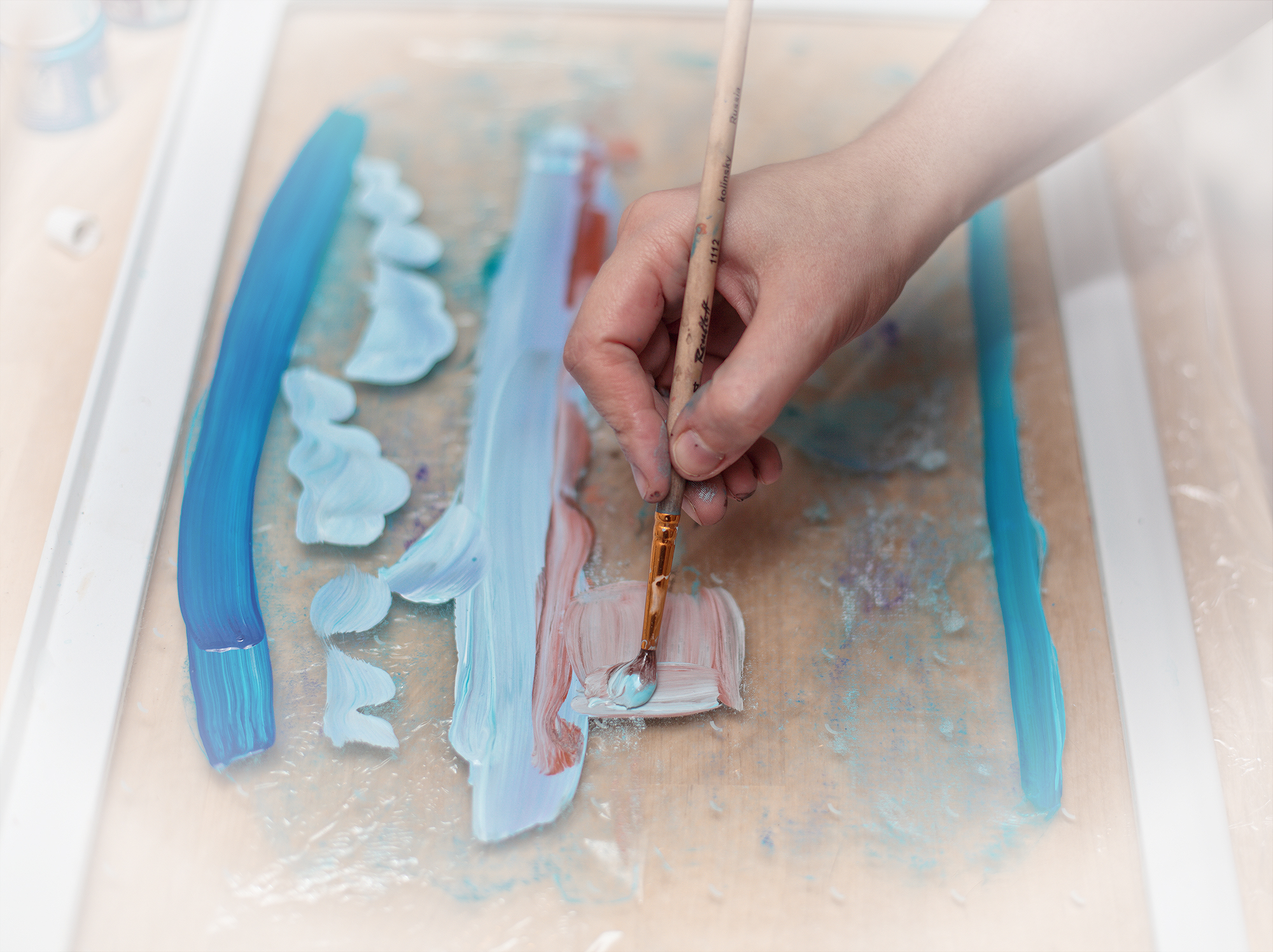
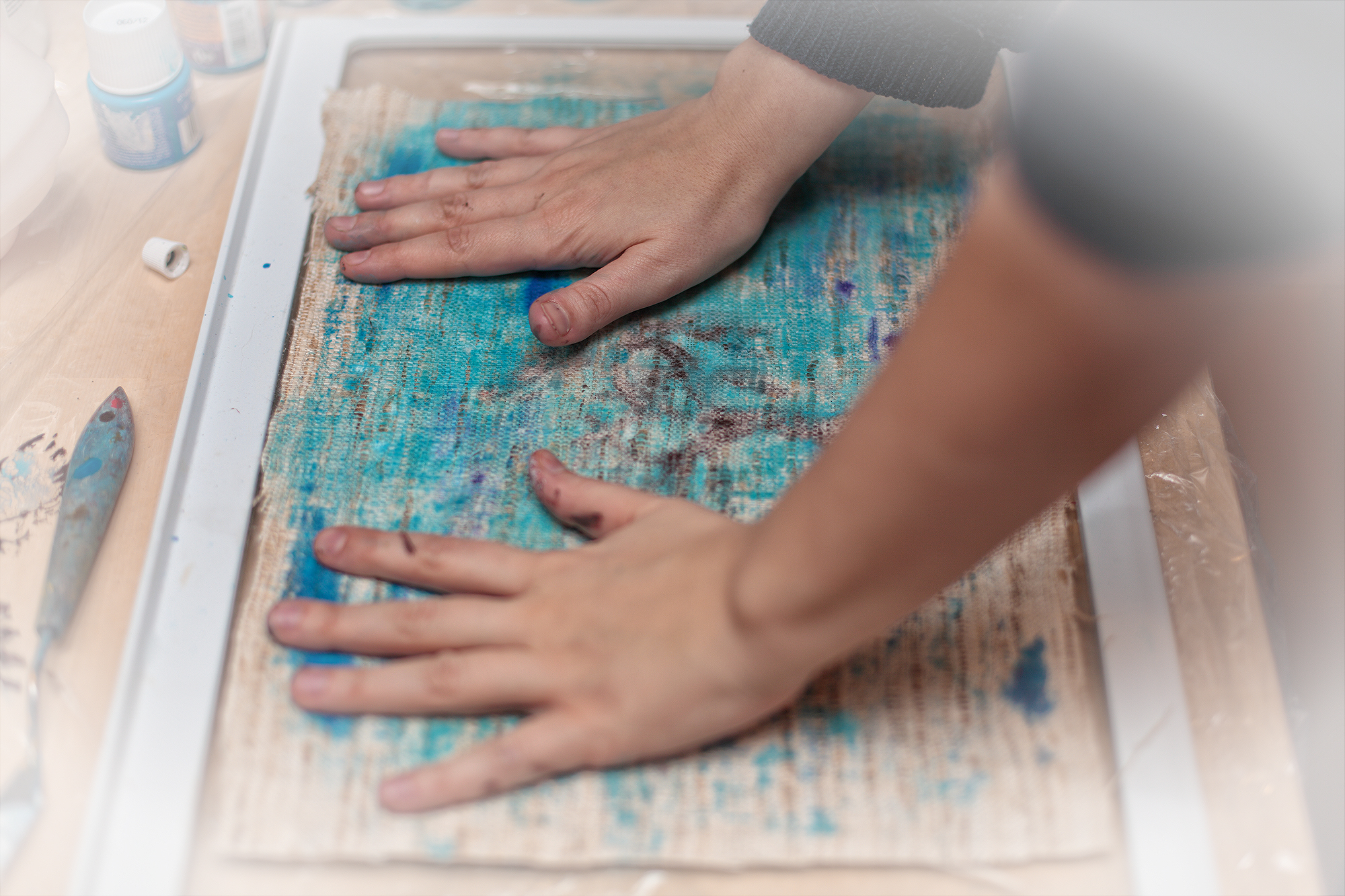
Chapter 7. Fantasy and image anchoring.
Hooray! Now, we can dream up about what we got and add some surprises to the shape by strokes. We did not plan the bird, house and a big moon.
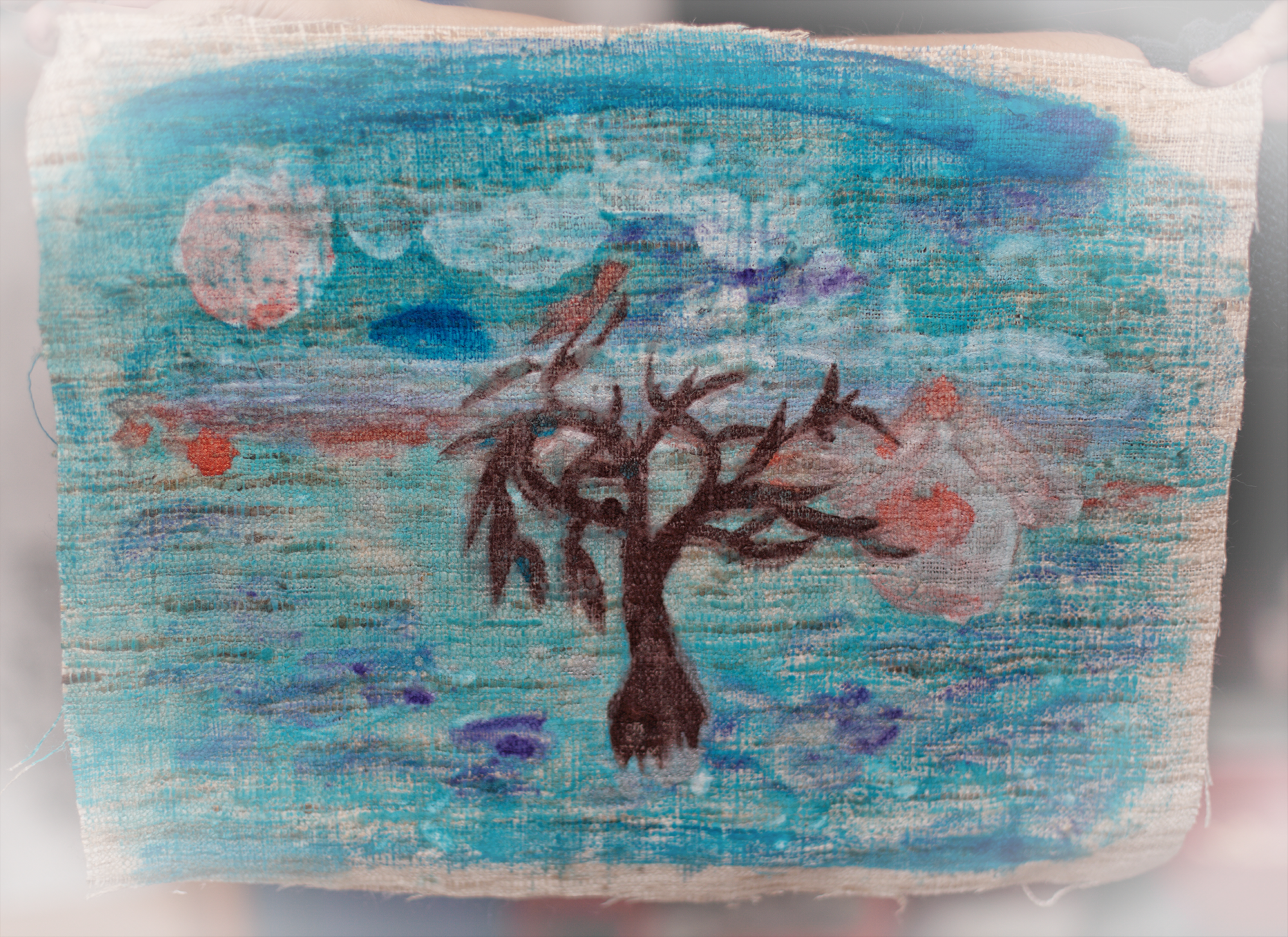
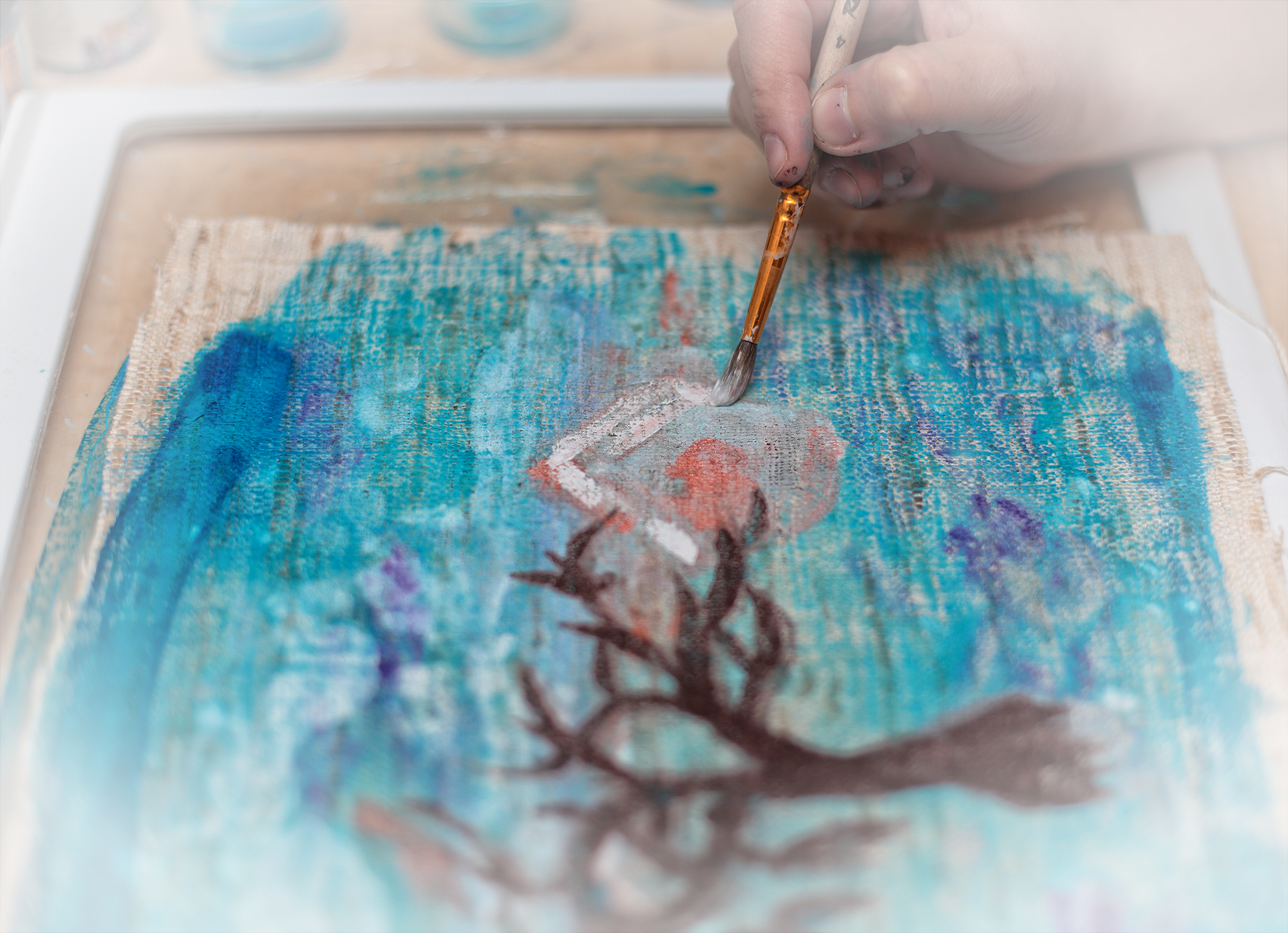
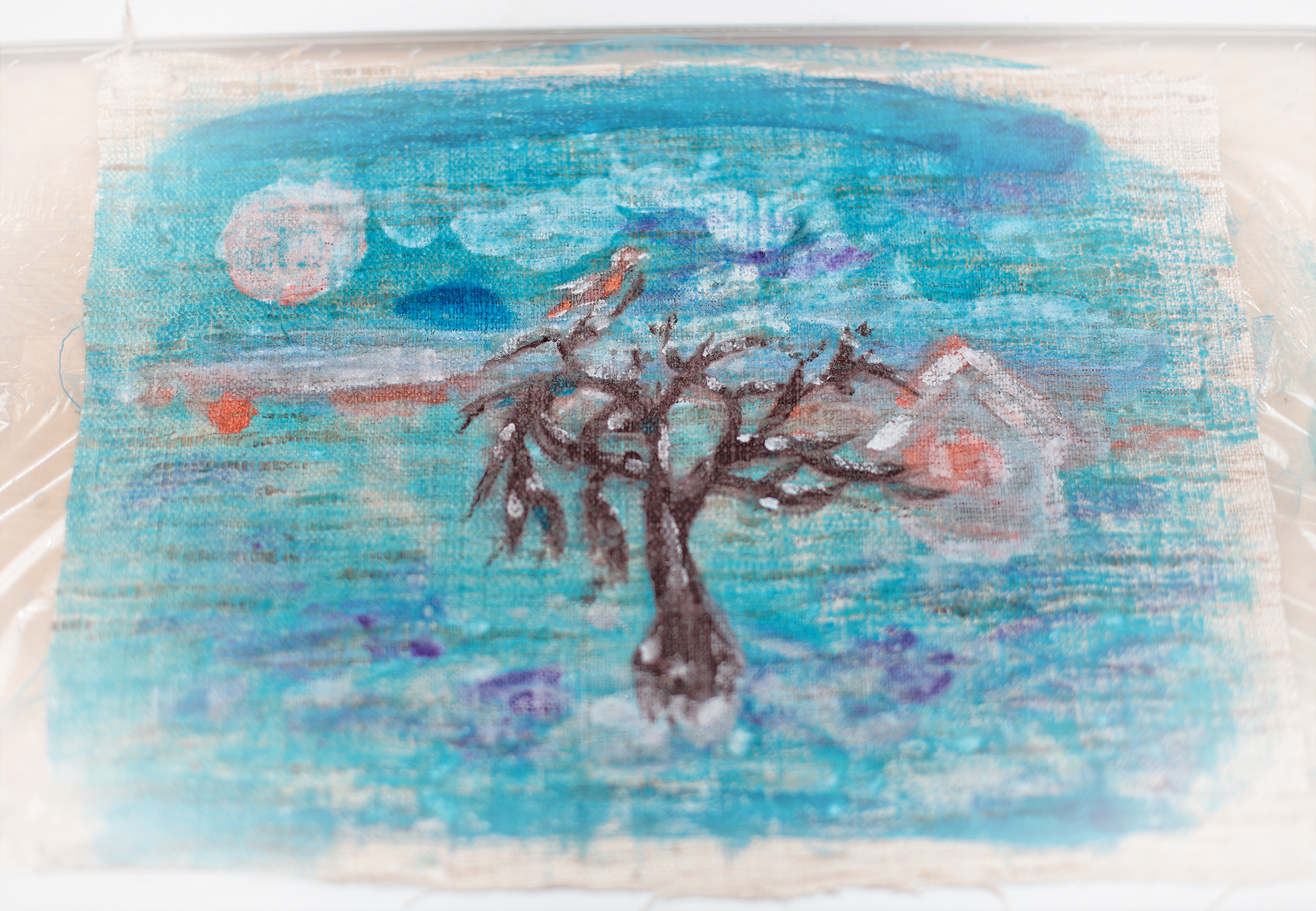
After the image dry, it will change a bit, so we may rejoice how bright and unexpected it turned out.
To consolidate the paints, it is useful to iron the whole product through some natural fabric in the “cotton” mode and then iron a bit right on the painting, but on its other side.
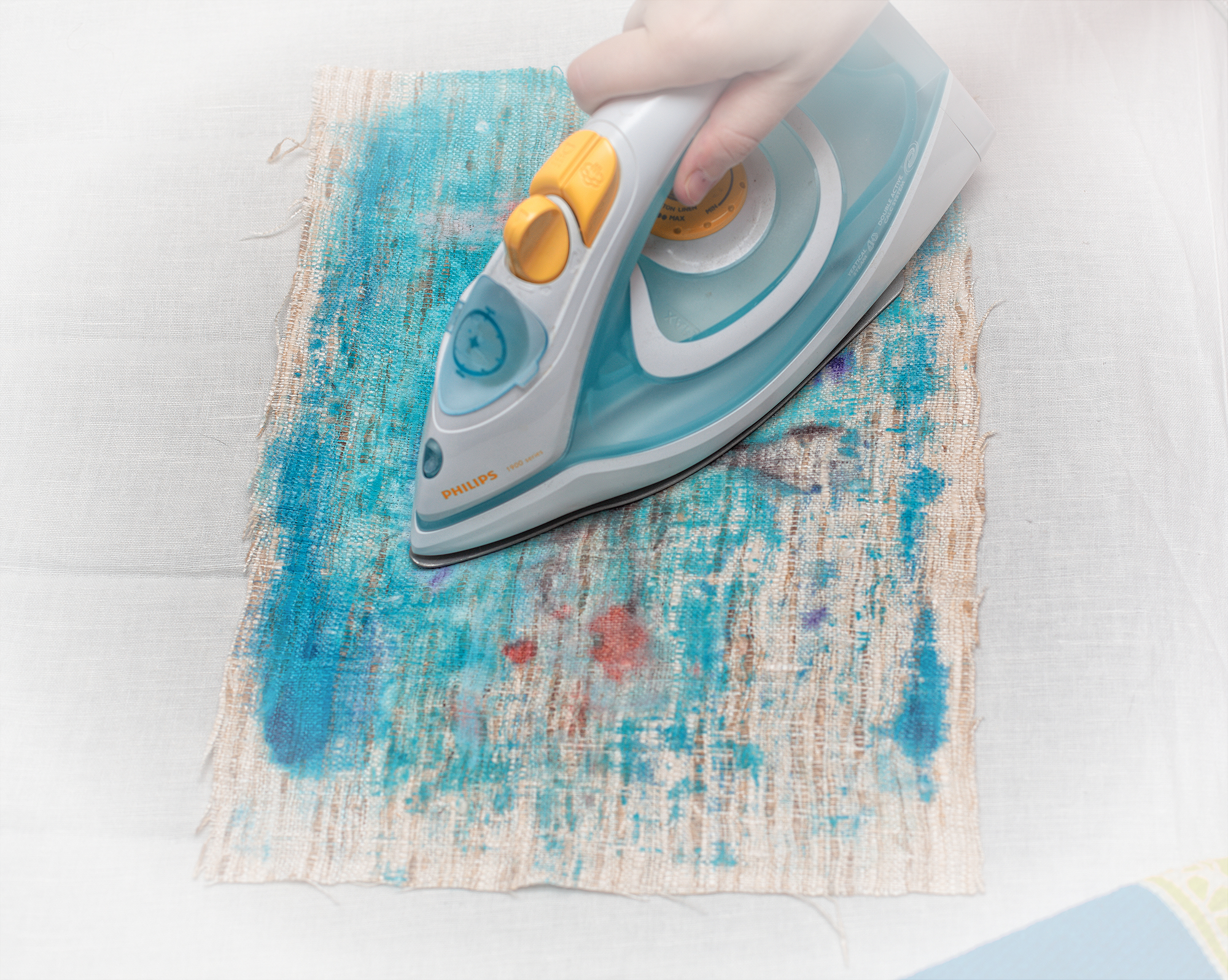
We can felt or sew the resulting image to a pillowcase, a decorative pillow, a handbag or an eco-package fashionable now.
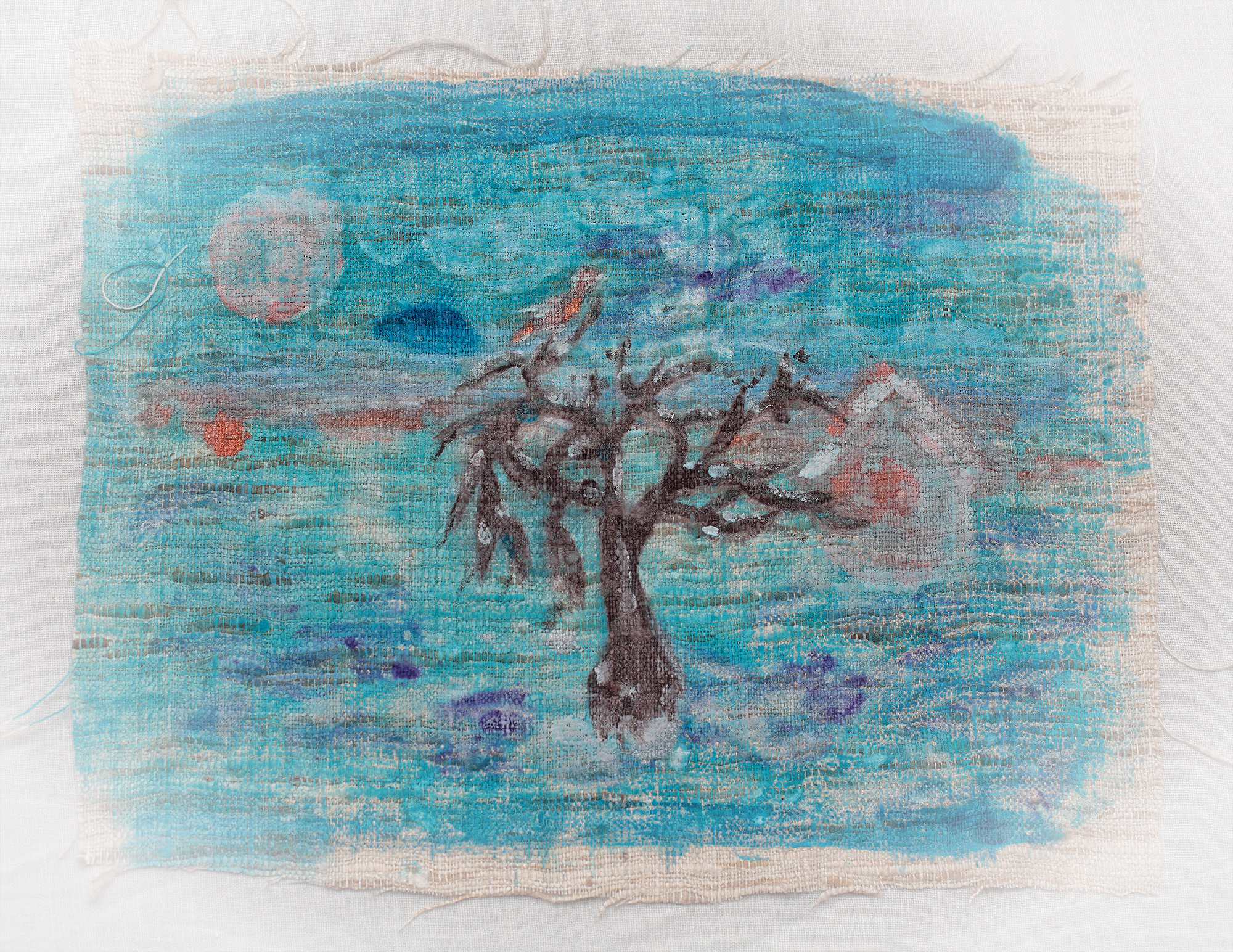
And don’t forget to clean up the mess on the working place!
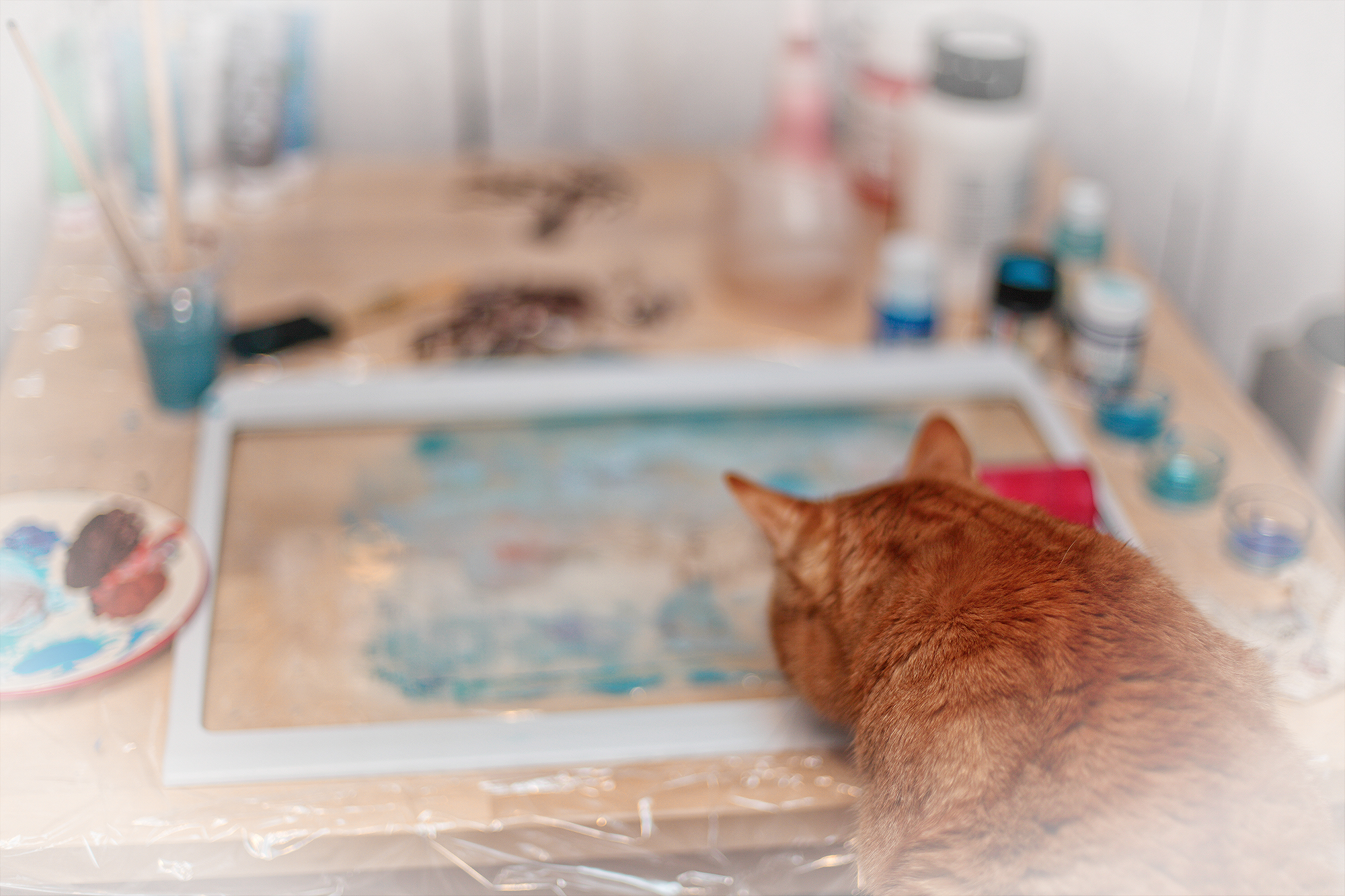
Let us be curious, will experiment and get the result not only in monotype. Good luck!
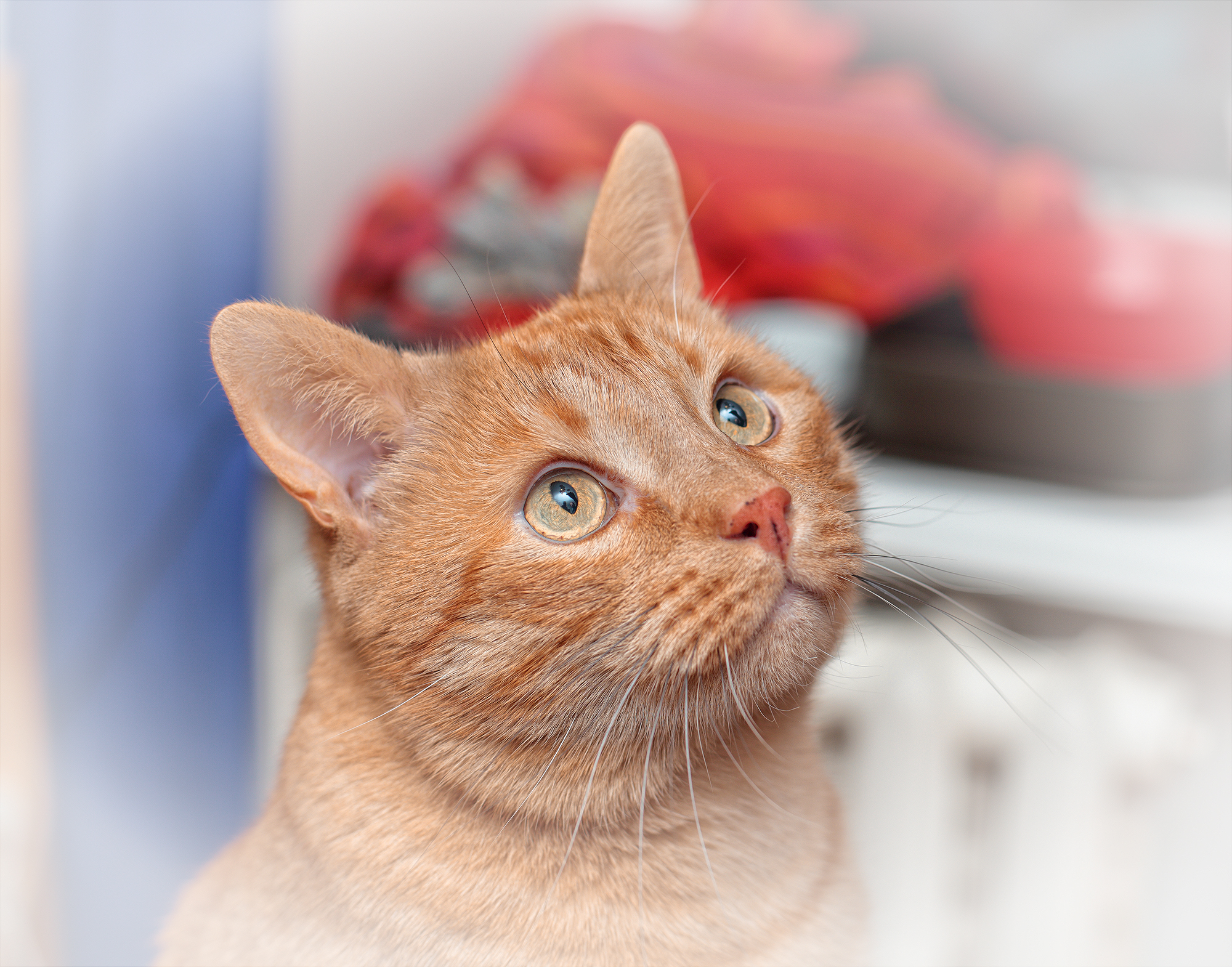
Text: Polina Kudelkina
Translation: Denis Churin
Photo: Denis Churin and Polina Kudelkina

